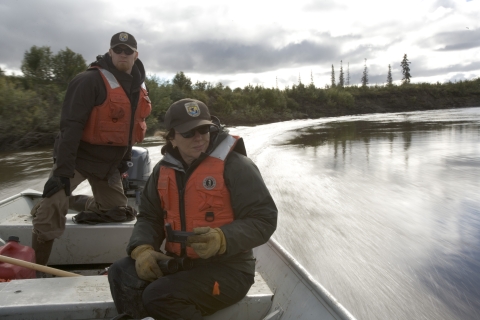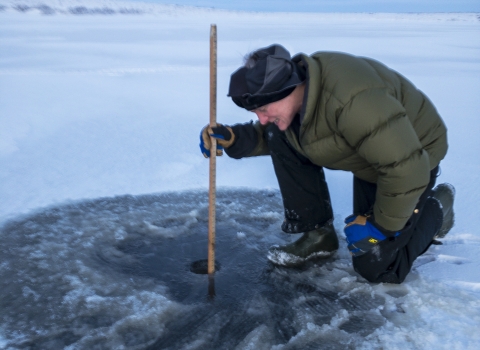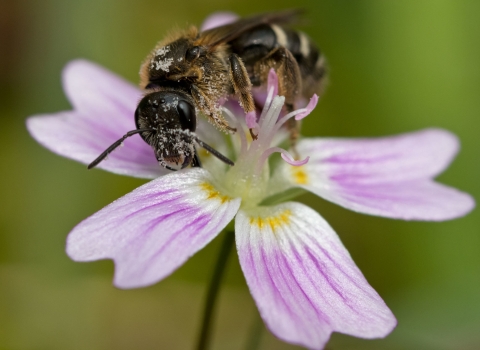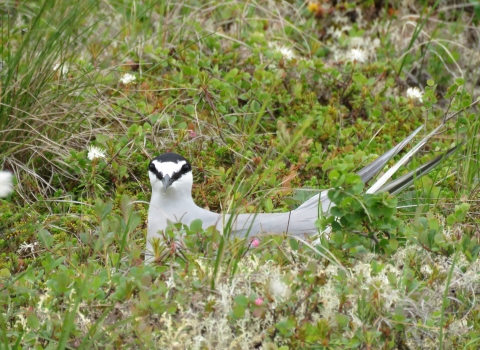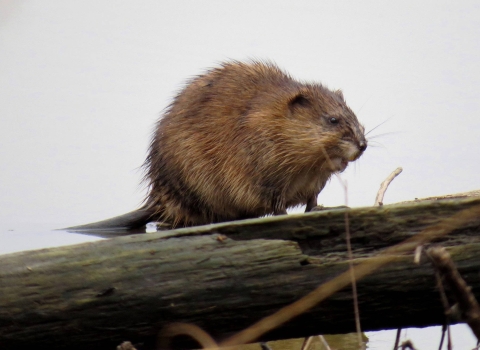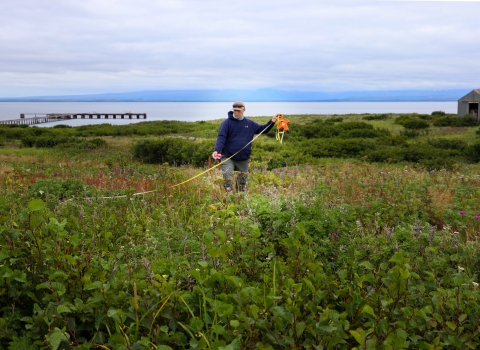Projects and Research
Selawik Refuge, in cooperation with other researchers and agencies, works to monitor wildlife populations and gain a better understanding of the natural systems within refuge habitats.
We have begun a broad-based ecological research program, focusing on understanding entire landscapes and ecosystems rather than single species. Climate change is already apparent in the Arctic, and is expected to lead to profound shifts in ecosystem dynamics. To prepare for this, we must advance our knowledge of the basic structure of our ecosystems, including nutrient and energy flows, food webs, soil and water chemistry, permafrost, and other landscape processes. Traditional wildlife monitoring can tell us how wildlife are affected by changes once they occur, but only a deep understanding of the ecosystem can help us anticipate change and monitor resources wisely.
Here in Northwest Alaska, our summers are often warmer and our winters less cold than in decades past. Breakups are coming earlier, and freezeups later. How do these changes influence the water temperatures in our rivers?
And what does this mean for creatures living in the rivers?
Warmer water holds less dissolved oxygen, and is less suitable for certain species of Alaskan...
Each winter beginning in 2018, Bill Carter and Sonny Berry of Selawik Refuge have been measuring ice thickness. The refuge has two measurement sites, one for each of the staff members: a lake near Kotzebue (Bill) and the Selawik River just above the village (Sonny). The measurements are collected monthly and submitted to the National Weather Service's Alaska-Pacific River Forecast Center (...
How often do you notice bees - only when one flies near you? Bees are actually VIPs: very important pollinators. Worldwide, bees play a part in 1 of every 3 bites of food people eat. For a group we know is so important, relatively little is known about wild bee species across much of Alaska. That’s where the "Alaska Bee Atlas" project comes in.
...Each fall for the past 15+ years, students, elders, teachers, and community members from the Iñupiaq village of Selawik have celebrated their connection to land and culture at a Science-Culture Camp. Every morning for two weeks, rain or shine, participants eagerly climb aboard boats for the 15-minute ride to the camp. Highlights from camp include catching and processing fish for drying...
If you have spent time in the summer along the coastline of Alaska, chances are you’ve encountered a tern. Terns are graceful, pale grey seabirds that float between land and water, hovering and diving for small fish. Tern species in Alaska have long narrow wings, forked tails, and black caps.
Take a closer...
The Land Use and Environmental Change oral history project on Project Jukebox contains interviews with elders in the community of Selawik, Alaska. Elders discuss the history of land use and environmental conditions on the Selawik Refuge in the early to mid-20th century, including information on traditional family settlements, muskrat hunting and trading, other key subsistence activities, and...
Selawik Refuge has one long-term alpine vegetation monitoring site in the Hockley Hills, part of the international Global Observation Research Initiative in Alpine Environments (GLORIA) project.
In 2006, Selawik refuge was accepted as an observation site within a worldwide monitoring network studying the effect of climate change on high mountain environments. This allow...
As part of the National Wetlands Inventory, we are mapping and digitizing high priority wetlands in Alaska’s 16 National Wildlife Refuges.
The U.S. Fish and Wildlife Service is the principal federal agency tasked with providing public information on the status and trends of our Nation's wetlands. Our National Wetlands Inventory provides detailed information...
Invasive Species Program staff collaborate with Alaska's National Wildlife Refuge, the State of Alaska and other partners to protect Alaska's lands and waters by working to detect invasive species infestations while they’re still relatively small and have the highest chance of being successfully eradicated. We survey terrestrial, freshwater, and marine environments for invasive plants and...
In the spring of 2004, thawing permafrost caused a large landslide (slump) in the upper Selawik River within Alaska's Selawik National Wildlife Refuge. As the slump grew it discharged tons of sediment upstream of the Selawik sheefish population's spawning grounds. This fish is an important Refuge fixture and year-round subsistence food for the Inupiat people living in the Selawik/Kotzebue...
